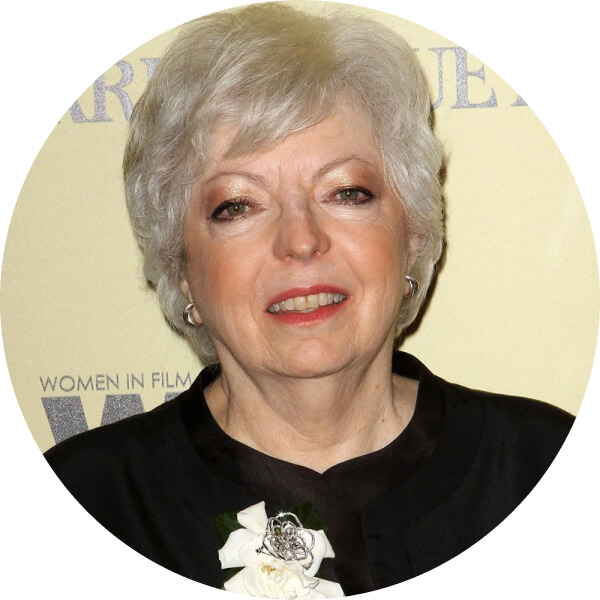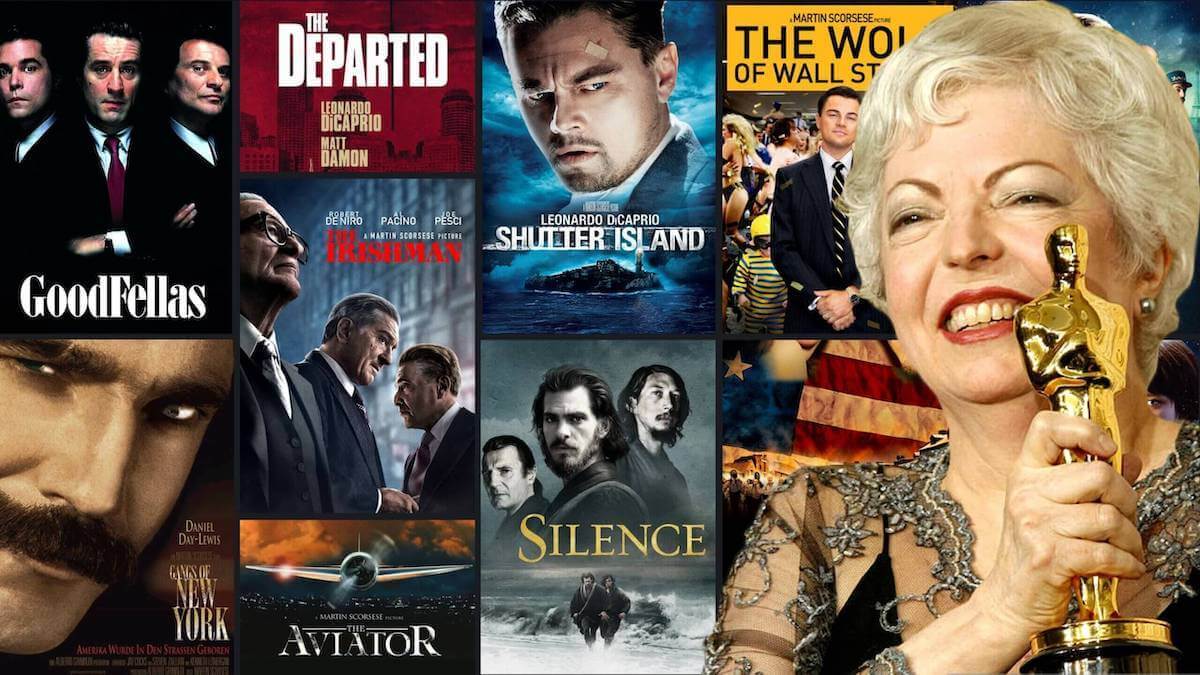Film editing is an underrated art form, and oftentimes under-appreciated. Editing is the backbone of filmmaking — it takes a lot of hard work and dedication to the craft, including developing one’s own unique editing style, and breaking the rules. Let’s examine one of Hollywood’s most accomplished and notable film editors, Thelma Schoonmaker, and discover what led her to become one of the most prominent names in the business. In this post, we’ll get a brief Thelma Schoonmaker biography, look at her unique editing style, and of course her decades-long collaboration with filmmaker and pioneer of cinematic techniques, Martin Scorsese.
Thelma Schoonmaker biography
How Thelma got into editing
Schoonmaker is largely known for her work including Raging Bull, The Aviator, The Irishman, The Departed, The Wolf of Wall Street, and many more films you probably love. Let’s look into Schoonmaker’s life before she became the second-most-nominated editor in Academy Awards history.
Thelma was born in Algeria to American expatriates, but spent her early years in Aruba. It wasn’t until she was fifteen years old that she moved to the United States with her family and pursued her studies. Surprisingly, editing films wasn’t Schoonmaker’s original passion. She studied political science and international diplomacy at Cornell.
It was during a graduate course in primitive art at Columbia University that she would soon be able to pave the way to award-winning editor status.
Related Posts
Even though she didn’t start out in film school, Schoonmaker found her passion fairly quickly. While in the course, she saw an ad in The New York Times for an editing assistant position. She applied, got the job, soon found the subject interesting, and then enrolled in a film editing course at NYU.
In the film industry, networking is key to success, and this was the case with Thelma Schoonmaker. Through her NYU course, she met young filmmaker Martin Scorsese, who asked her to fix an editing issue on one of his first films. The two went on to collaborate on 23 feature films (and counting).
Check out the above interview to hear Schoonmaker in her own words describe favorite parts about working with Scorsese and her favorite movie moments.
Thelma Schoonmaker interview
A trademark Schoonmaker and Scorsese are known for is working with improvisation, which Schoonmaker says she loves to do. For example, remember the pivotal scene in The Departed where Jack Nicholson pulls a gun on Leonardo DiCaprio after discovering he was a rat? That scene was totally improvised, and Leo’s reaction was in real-time!

I love cutting improvisation because it’s like putting a puzzle together and that’s what it’s like working with an improvised scene. You have to find a way to make that work dramatically as a scene and I love doing that.
— Thelma Schoonmaker
Thelma Schoonmaker and Martin Scorsese
Collaboration with Martin Scorsese
Many successful people will say collaboration is a key component to success, and this is the case for Schoonmaker and Scorsese, who together created many award-winning films, including the three-and-a-half hour long film
The Irishman. Here's a breakdown of The Irishman's opening scene.
Thelma Schoonmaker Editing Style • Subscribe on YouTube
Schoonmaker stayed humble throughout her success, reiterating the importance of collaboration, teamwork, and ensuring the director’s vision comes to life. Schoonmaker’s editing skills accompanied with Scorsese's directing style created one of the best cinematic marriages of all time.
Film editing is no easy feat. Schoonmaker and Scorsese worked painstaking hours to create epic film imagery for movies like Raging Bull, which ended up being voted as one of the best films of the 1980s. Schoonmaker won her first Academy Award as an editor for that film.
In fact, the film was so successful and they worked so well together, she subsequently edited every narrative film Scorsese has directed since.
A hallmark of Thelma Schoonmaker films is her ability to work with improvised elements, as seen in films like Raging Bull, Wolf of Wall Street. Schoonmaker said it was her work in editing documentaries that helped train her for editing improvised film footage.
Watch the below Thelma Schoonmaker interview to get some insight into editing, in her own words!
Thelma Schoonmaker interview on her process working with Scorsese
As she explained in the video above, working with Scorsese is pure collaboration. While it may be his vision, he relies on her to help him get there. They begin by watching dailies and discussing the goals of the project. And this is where the key to a director-editor relationship — communication. In the next section, we'll discuss some of the specific editing techniques that have shaped the best Scorsese movies and defined her editing style.
Thelma Schoonmaker’s editing style
Thelma Schoonmaker editing style
There are many different kinds of editing techniques and transitions you can use to elevate your projects, like cross cutting and match cuts.
If you thought good editing means people don’t notice it is happening, this isn’t the case for Thelma Schoonmaker films. A tip to creating great craftsmanship is to ditch conventional rules, and that’s exactly what Schoonmaker and Scorsese accomplished with their filmmaking and editing styles. Thelma Schoonmaker films’ editing style and unique techniques are part of what makes her and Scorsese films so successful.
Here are just a few of the distinctive and clearly visible editing techniques Schoonmaker used in some of her most notable films. Be sure to watch the video below to see the examples in action!
Thelma Schoonmaker Martin Scorsese editing style
Freeze-frame
When a single content shows repeatedly on the screen—"freezing" the action, which produces a still shot (that resembles a photograph). In Goodfellas, Scorsese's visual tricks using freeze frame shots to stop the action at significant points in Henry's life. Like when he is staring down at the trunk and says "As far back as I can remember, I always wanted to be a gangster."
It’s also visible when Henry torches the cars. The freeze frames are used here to let the viewer know what Henry remembers as critical moments in his life, allowing us to resonate more with the character.
Flashbulb cut
Kind of self explanatory. This involves a cut using the flashing of cameras. Schoonmaker uses flashbulb differently in many of Scorsese' films to capture different kinds of emotions. In the film Aviator, a flashbulb is used as a disorienting effect.
The flashbulb cuts are shown in a sequence as paparazzi camera flashes are blasting in Hugh’s face as he walks Harlow down the red carpet, clearly uncomfortable with all the attention. The flashbulb edits are helpful in creating that feeling of disorientation, allowing the viewer to feel what the character may be feeling.
Slow Motion
Slow Motion is an effect used in editing where time appears to be slowed down. This technique is visible in Raging Bull when the Ray Robinson character beats Jake to a bloody pulp. The slow motion of the hard punches works during this fight scene because it serves as a juxtaposition and creates more of a feeling of chaos. The slow motion adds a level of intensity to the action, builds tension and keeps the audience on the edge of their seats.
What it comes down to is that there are no universal truths to editing. There is no right way, because you get to cut (or not cut) based on how you want your audience to feel.

We like a certain roughness sometimes in the film editing style that Hollywood editors wouldn’t like. Hollywood editors tend to like a slick style of editing, where all the bumps are removed. But, sometimes Marty and I like to keep in those bumps, because they add a certain grittiness to the film, a certain reality.
— Thelma Schoonmaker
UP NEXT
Martin Scorsese Filmmaking Techniques
Want to know more about unique filmmaking styles? Or perhaps you want to be an editor yourself and want some more inspiration? Check out the Martin Scorsese article to discover more on Scorses’s filmmaking and learn about some more of the editing techniques he and Schoonmaker used to create celebrated cinematic art.
Up Next: Martin Scorsese style →
Showcase your vision with elegant shot lists and storyboards.
Create robust and customizable shot lists. Upload images to make storyboards and slideshows.
